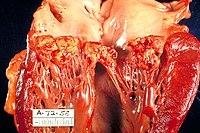
Photo from wikipedia
Cutibacterium (Propionibacterium) acnes (C. acnes) is a human skin commensal that can become invasive, particularly associated with indwelling medical devices such as prosthetic heart valves, cardiac pacemakers, artificial limb joints,… Click to show full abstract
Cutibacterium (Propionibacterium) acnes (C. acnes) is a human skin commensal that can become invasive, particularly associated with indwelling medical devices such as prosthetic heart valves, cardiac pacemakers, artificial limb joints, shunts and vascular catheters. C. acnes produces the biofilm and can reside there in a reversible low metabolic activity state evading the host’s immune system defenses and antibiotic therapy for many years without exhibiting clinical signs of infection. Late diagnosis of C. acnes prosthetic valve endocarditis (PVE) can result in intracardiac abscesses, prosthesis dehiscence and heart failure. These complications significantly increase the complexity of cardiac surgery and are associated with up to 40% in-hospital mortality. We have reported a case of recurrent C. acnes PVE that required multiple operations for removal of the infected prosthesis, cardiac debridement and implantation of a new heart valve prosthesis. In patients with persistent or recurrent PVE in whom cardiac surgery has failed to eradicate infection, heart transplantation (HTx) may be considered as salvage treatment. We describe progress in the same patient with recurrent C. acnes PVE who underwent successful HTx six years after his last prosthetic valve replacements. A 59-year-old male presented for orthotopic HTx and removal of a permanent pacemaker for New York Heart Association class IV heart failure due to severe mitral paravalvular regurgitation. He had a history of rheumatic heart disease and underwent seven cardiac operations including six redo prosthetic heart valve replacements for C. acnes endocarditis, which was initially culture negative as we have previously described. On 9 June 2019, this patient underwent HTx. Following the recipient’s heart explantation, a large mitral periprosthetic dehiscence was confirmed (Fig. 1). Microbial cultures of the explanted mitral and aortic prostheses and a left atrium specimen yielded growth of C. acnes. The patient’s post-operative course was uncomplicated. He remains in good health 11 months later and receives lifelong penicillin treatment for prophylaxis of endocarditis. To the best of our knowledge, this is the first report of curative treatment for recurrent C. acnes PVE with HTx. Our experience with this patient supports the 2015 ESC Guidelines for management of infective endocarditis recommendations which consider HTx to be a curative option when repeat operative procedures have failed to eradicate PVE. Informed consent was obtained from the patient for publication of this study.
Journal Title: ANZ Journal of Surgery
Year Published: 2020
Link to full text (if available)
Share on Social Media: Sign Up to like & get
recommendations!